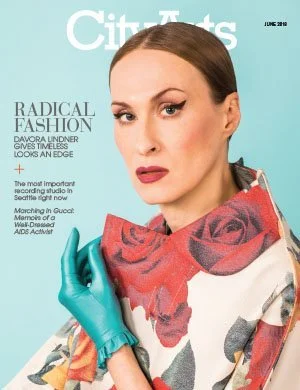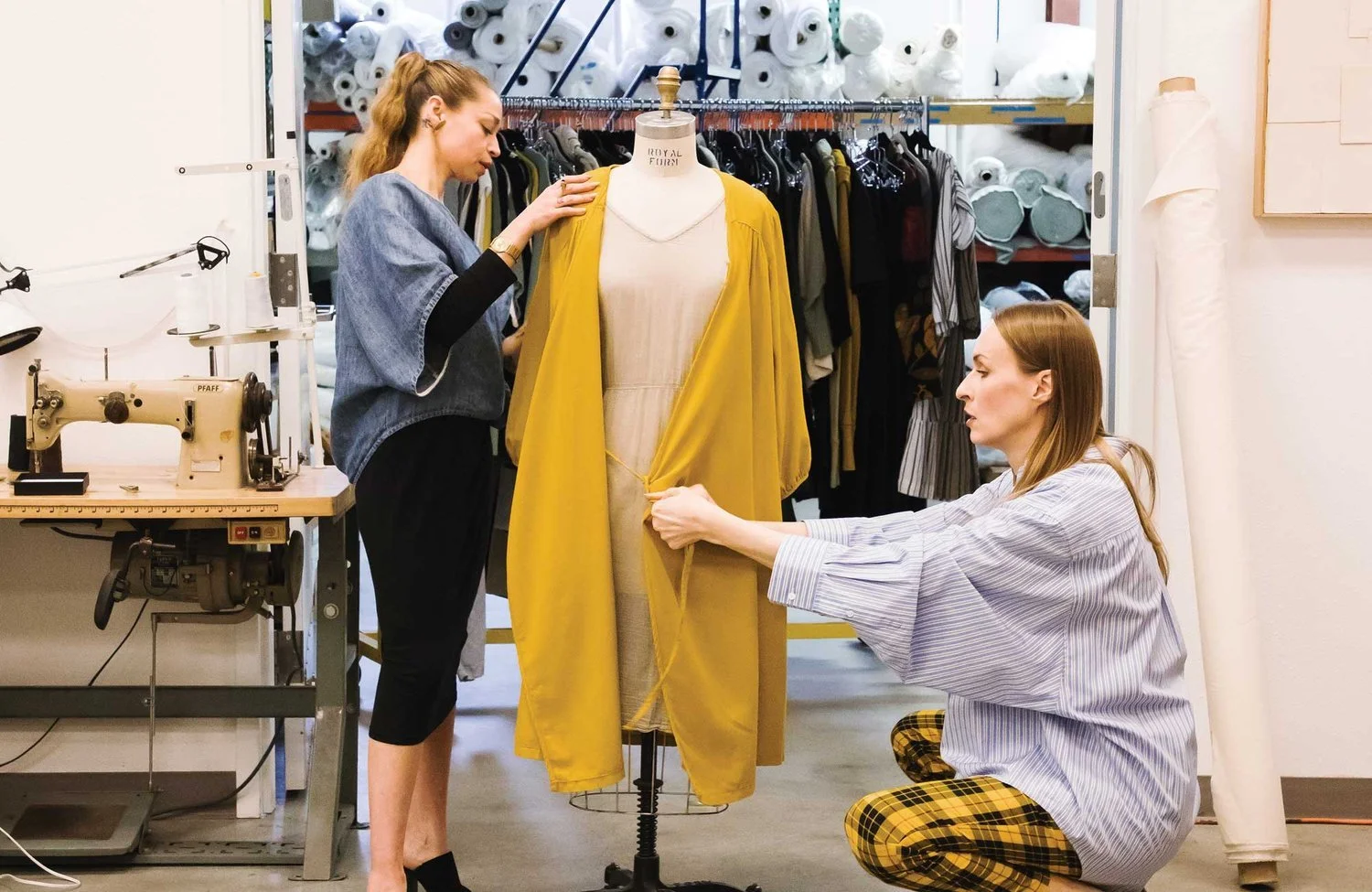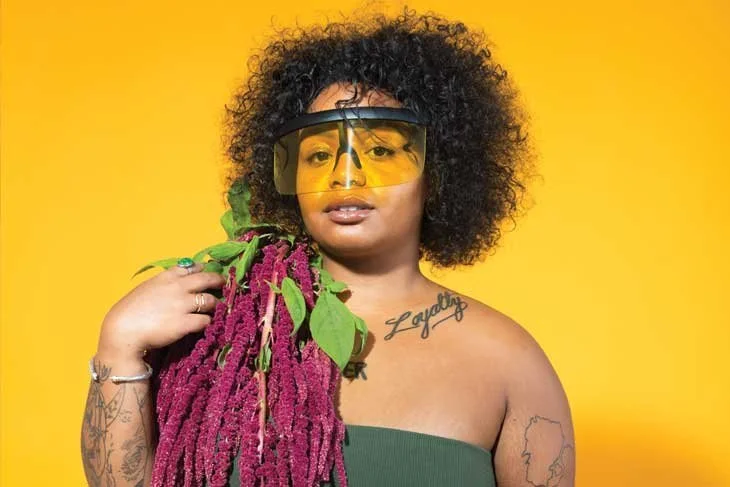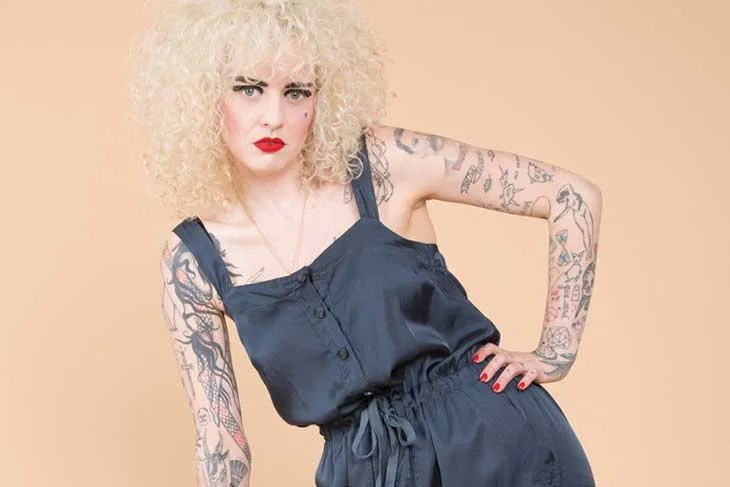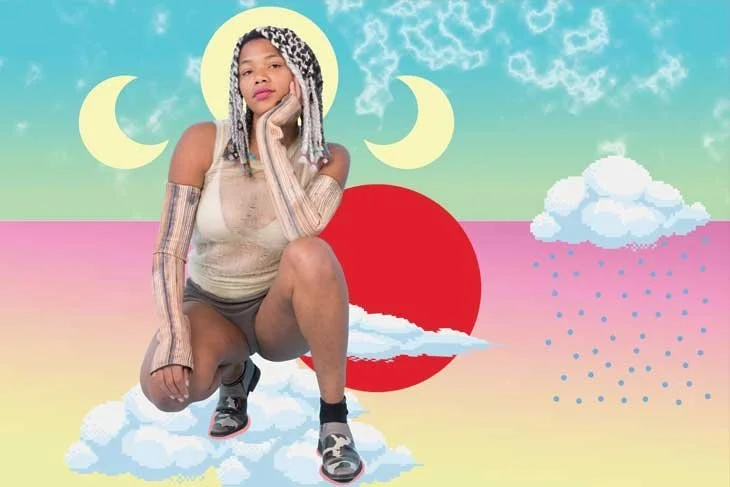CITY ARTS, MAY 2018
Ethical Aesthetics
Davora Lindner revolutionizes art and fashion at Prairie Underground
by Amanda Manitach
City Arts Magazine, May 2018
Cover photo by Steven Miller
Davora Lindner with Lilia Ramírez, Prairie Underground’s bookkeeper and stylist, working at the Georgetown site on a dress form fitted with their Bloomsbury Dress layered over a Trousseau Dress. Photo by Lauren Max
Sitting in her office, Lindner wears flowy, black Comme des Garçons overalls over a black Armani blouse cinched at the waist and a pair of nude TOMS slides. The look is understated but impeccably glamorous. She’s surrounded by clothesmaker’s arcana:
A bookcase behind her is stuffed with oversized binders labeled Green Textiles, Dyes and Buttons. Lindner is co-founder of Prairie Underground, an iconic Seattle clothing company that’s had tendrils in the local art scene for years. The brand name’s two words are tactfully subversive and so not Northwest. Together they encompass the intent behind the company Lindner created 14 years ago with Camilla Eckersley, who Lindner has known since they were both growing up in Lincoln, Neb.
“Prairie Underground embodies the idea of political uprising, insurrection and a secret society,” Lindner says.
Vocalist and songwriter JusMoni, aka Moni Tep, in Prairie Underground’s Sidewalk Talk (worn as a bodysuit).
Prairie Underground garments have a uniform-like quality: chic, timeless staples like shirtdresses, cardigans and fitted cigarette pants but with bespoke cuts, pleats and shrouded details that make each garment fall just so. The designs play with boxy, architectural silhouettes, harkening to the simplicity of design past—the austerity of early 20th-century workers’ clothing crossed with the chic flow of classic ’60s and ’70s design. Production runs are small, anywhere from 50 to 300 pieces of any given design. The palette is the stuff of earth: olive, indigo, bruise, graphite. Fabrics are sustainable cotton and hemp. It’s all sewn entirely in Washington. Though the company works with a number of boutiques across the country, it sells most of its inventory via its website, where it has a loyal following.
Valentine’s Tattoo owner Shannon Perry in the Hyper Kinetic romper.
Prairie Underground’s projects extend beyond their signature line. Womxn’s Rites is an altruistic offshoot offering intimates and loungewear to raise money for social justice causes. Designers such as LA-based Pierre Davis’ NO SESSO non-binary clothing company and design duo FEMAIL have collaborated with Prairie Underground to create customized garments, embroidered or altered in their respective signature styles.
As much as the HQ is filled with clothing, it’s equally brimming with art. Every second Saturday of the month, in conjunction with the Georgetown Art Attack, Prairie Underground hosts visual art exhibitions in the showroom adjacent their warehouse.
The company’s marketing also employs visual artists, who they call on to reimagine their clothing through photography, sculpture and installation. Since 2015, their series of artist collaborations have commissioned work by Frank Correa, Rumi Koshino, Megumi Shauna Arai, Francesca Lohmann, Lauren Gault and others. On the side, Lindner has served as a board member at On the Boards for four years and co-curated art exhibitions for events like Seattle’s queer music and arts festival Mo-Wave.
The current art exhibit in the showroom—called softcore, presented by the nascent curatorial group and Capitol Hill gallery called FOUND Space—includes minimalist draped sculptures hanging from the wall, swaddling cast fragments of pleated cement and other such assemblages made by artist Lauren Fejarang. During the exhibit’s opening reception, choreographer Imana Gunawan performed in the space, responding to the work.
As Lindner describes the ephemeral performance, as well as the litany of other artful things afoot at Prairie Underground, she is interrupted by the arrival of a plumber. Nothing here at the warehouse seems to be amiss on the surface, but something’s gone wrong below. The nuts and bolts of running an independent design business aren’t always the stuff of glamour.
“We’re having a real River of Fundament moment,” she says, laughing, referring to the fecal-forward imagery of a Matthew Barney exhibit she saw in Los Angeles. “We’re literally cleaning up sewer water today. It’s another Prairie moment.”
Lindner, now 47, was born in Seward, Neb., then moved to Lincoln as a child. Those years in the heart of the Midwest left an imprint, a formative vision of endless horizons and long winters.
“It’s a great place for someone to grow up who’s introverted,” she says. “I was an indoorsy kid, and let’s put it this way: The event schedule there is not going to tax anyone.”
Though she suffered hay fever and would have preferred to cloister with music and magazines, Lindner spent much of her time in the blistering sun. Her ancestors were farmers, her parents entrepreneurs. Her father owned a company specializing in industrial blasting and painting of large steel and concrete structures. She and her four siblings were recruited to pick up a brush and pitch in as soon as they were able.
DoNormaal wearing No Sesso gloves, a vintage Helmut Lang top and Hand Loom Shorts by Womxn’s Rites.
Lindner ached for culture and sought out Lincoln’s then-scant offerings; she connected with life outside the Midwest in the record store. “It was our means of communication with the greater world,” she says. “It’s where I went to receive broadcasting about what was happening in other cities in the States and abroad.”
She found inspiration in British punk artists, New Romantics and others transmitting ideas through music and fashion, which had always been obsessions for Lindner, a key to unlocking identity. Then there was the sheer joy of luxuriating in material. As a kid Lindner loved folding clothes, arranging items in perfect stacks. She drew imaginary catalogs complete with pricing and 1-800 numbers. She shoplifted, ripping off not clothes themselves but the brand labels from items she couldn’t afford. She’d then pin them on her bedroom wall.
“There was an attraction to branding and this world of fashion, the mystery and allure of that. I just needed to have proximity to it,” she says. “When I’d travel to Vegas with my family on vacations I’d go to Louis Vuitton and try on half the collection. I’d lock myself in the dressing room and not answer when the attendant came by. I had to wear these clothes for a moment, even if I couldn’t afford it.”
In high school, she befriended future Prairie co-founder Camilla Eckersley. As teens they participated in anti-nuclear demonstrations at military sites, often trekking on foot from Lincoln to Omaha to protest. Eckersley was arrested at one.
Eckersley also found a haven in fashion, sewing and altering clothing through her teens, creating a label she called XL that consisted mostly of oversized white T-shirts and knickers made from old flour sacks. “Clothing for me was a big part of my personal expression,” Eckersley says. “Customizing vintage clothing, old Levi’s, my Dad’s hand-me-downs, was part of how I expressed myself. This did include political protest signs and images as well as ’60s go-go boots, wigs and tie-dyed clothing.”
Lindner’s burgeoning interest in design led her to pursue a BFA in fashion at Minneapolis College of Art and Design. Studying fashion in the Midwest was limiting and she knew it, and her family couldn’t afford a school like Parsons, so instead she shifted her concentration to performance and installation.
It proved a good choice. Lindner was a standout student and artist, and while she was in school was awarded an independent study program to live and work in a loft in Tribeca for a year. It was the ’90s and Lindner’s focus had shifted to activist art. On Friday nights, armed with walkie-talkies, she roamed with the Pink Panthers, a civilian group that patrolled the streets of the West Village to combat anti-LGBTQ violence.
She took part in iconic protests like the March on Washington for Lesbian, Gay, and Bi Equal Rights and Liberation in ’93 and attended the memorial for artist David Wojnarowicz.
“There was an attraction to branding and this world of fashion, the mystery and allure of that. I just needed to have proximity to it.”
After her year in New York, Lindner returned to Minneapolis to make art while working part-time with an organization to assist people suffering from intellectual disabilities. Her art was being celebrated by institutions if not by collectors, and she was awarded the Bush Fellowship—a grant large enough to allow her to make art full-time.
During that year she made sculpture and video and ran a public-access show called Serious Matters. The sculpture comprised small figurative ceramics that she incorporated into stop-motion animation and installations. “The work had an abject quality, these doll-like figures,” she says. “They referenced a sort of mythological magical creature, alluding to transformation. It was a result of an aggregate of personal experience focused on gender. This was still pretty early on in the conversation, and you were kind of seen as mentally ill talking about transgender experiences. It was a different era.”
Making art full-time that year was a wake-up call, and it convinced Lindner to start her own business, one that would support and nourish her creative career. She called Eckersley, who’d moved to San Francisco and was working as a clothing designer for another company, but was ready to start her own business as well. For Lindner, a return to fashion seemed a way to channel energy into making objects more accessible, easier to integrate into everyday lives.
“Fashion—it’s always been there as a way to create identity and make statements about identity, to influence culture and shift perception,” Lindner says. “Another influence for me was always The Philosophy of Andy Warhol and his approach to combining business and art—the idea that the business of design could also be an art project.”
Torn between starting a business in Seattle or LA, Eckersley and Lindner visited Seattle in the picture-perfect summer of 2004 for some R&D. They booked a day room at the Capitol Hill Library where they drew up a business plan for Prairie Underground. Three months later they sold most of their possessions and relocated to the Northwest. To walk out of her First Hill apartment and see the water instead of that big sky horizon was an unexpected balm. Lindner was hooked.
“I didn’t realize how much more liberal Seattle was until I moved here,” Lindner says. “I have this intense memory of smoking a cigarette while driving my car and throwing the butt out the window. The car behind laid on the horn. I literally thought my car was on fire he was honking so much. He rolls up to me and says, We don’t do that here! I try to reenact that now, try to uphold the incredible values people have here. They might be difficult, but they have real impact.”
Still, Nebraska echoes in the imaginations of both Lindner and Eckersley.
“There’s something at work with Midwest Depression-era values that are a true aversion to waste,” Lindner muses as she sits in her office. “My grandparents in Nebraska were recycling in the ’70s. In small communities there’s a more acute awareness that you don’t have unlimited resources, that you have to create things yourself. It’s a more holistic way of life that capitalistic society has pushed us away from. It’s a really poetic and beautiful model, for both business and society. Relationships can be enhanced by it.”
The philosophy of no waste, product quality and art are the hub around which Prairie Underground operates. All their sewing is done locally. The textiles are sourced from sustainable, recycled or upcycled resources.
Prairie Underground has lived up to its name, building a team of designers with artistic backgrounds, growing gradually by word of mouth and amassing a loyal army of customers, but Lindner has mixed feelings about the growth of the city. “I’m lamenting the idea of living in a very progressive city with no heart, in a city that is teeming with ghosts,” she says.
She worries that the stories of those who have done so much work in art and activism in both Seattle and New York might be lost to short-sighted vision and short-term memory. That’s one reason Lindner has no intention of moving on: This is home, and the bustle and ever-expanding number of art spaces cropping up near her Georgetown warehouse thrills her. Such energy offers new ways of unfolding the Prairie Underground story—the politics of envisioning slow, green, alternative ways of manufacturing—while engaging artists.
“Our ideas are always evolving and changing,” Eckersley says. “When we started Prairie we knew we wanted to create something good in the world. What that is is an ongoing discussion. Davora and I are able to challenge each other while giving space for us each to pursue interests and passions. I tend toward tunnel vision and pure ideas of sustainability, environmentalism. Our collaboration allows me to see bigger picture ideas and different ways of approaching things.”
As Lindner checks in with the plumber to make sure the ground hasn’t split at the seams, she notes that one benefit of managing a huge warehouse is that it provides another way to support artists.
“That will always be a major driving part of our company,” she says. “To create knowledge and awareness of artmaking in this neighborhood.” Each exhibit they present comes with a small stipend for artists.
For Lindner, the commitment to art, activism, fashion and transformation is a constant; the script has never really changed. Prairie Underground’s slow fashion continues to leave its mark on Seattle, inscribing the city with a healing energy, looking forward to a future filled with endless possibility, compassion and the gift of self-invention.
